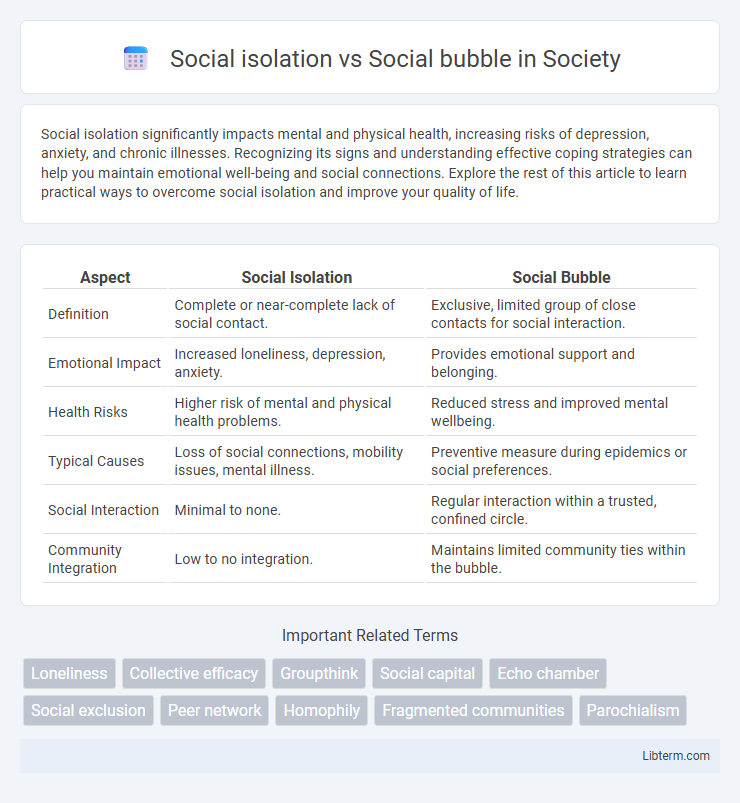Social isolation significantly impacts mental and physical health, increasing risks of depression, anxiety, and chronic illnesses. Recognizing its signs and understanding effective coping strategies can help you maintain emotional well-being and social connections. Explore the rest of this article to learn practical ways to overcome social isolation and improve your quality of life.
Table of Comparison
| Aspect | Social Isolation | Social Bubble |
|---|---|---|
| Definition | Complete or near-complete lack of social contact. | Exclusive, limited group of close contacts for social interaction. |
| Emotional Impact | Increased loneliness, depression, anxiety. | Provides emotional support and belonging. |
| Health Risks | Higher risk of mental and physical health problems. | Reduced stress and improved mental wellbeing. |
| Typical Causes | Loss of social connections, mobility issues, mental illness. | Preventive measure during epidemics or social preferences. |
| Social Interaction | Minimal to none. | Regular interaction within a trusted, confined circle. |
| Community Integration | Low to no integration. | Maintains limited community ties within the bubble. |
Understanding Social Isolation: Definition and Causes
Social isolation refers to the objective lack of social contacts or interactions, leading to minimal engagement with others and increased feelings of loneliness. Key causes include physical barriers such as geographic remoteness, health issues limiting mobility, and psychological factors like anxiety or depression that hinder social participation. Understanding these underlying reasons is crucial for recognizing the differences from a social bubble, which involves a limited but chosen group of close interactions rather than a complete absence of social connections.
What Is a Social Bubble? Key Concepts Explained
A social bubble is a designated group of individuals who agree to limit close contact exclusively within their bubble to reduce the spread of infectious diseases, contrasting with social isolation where interaction is minimized entirely. These bubbles create a controlled environment promoting mental well-being through safe social interaction while minimizing the risk of virus transmission. Key concepts include exclusivity, mutual agreement, and consistent interaction, emphasizing safety and social connection during pandemics.
Psychological Impact of Social Isolation
Social isolation significantly increases the risk of anxiety, depression, and cognitive decline due to prolonged lack of meaningful social interactions. In contrast, a social bubble limits interactions to a small, consistent group, mitigating feelings of loneliness while maintaining essential social support. Research highlights that maintaining a social bubble can reduce stress hormones and improve overall psychological resilience during periods of limited social contact.
Benefits of Forming a Social Bubble
Forming a social bubble limits the number of close contacts, reducing the risk of virus transmission while maintaining essential social interactions that combat loneliness and improve mental health. Social bubbles create a supportive network, enhancing emotional well-being by fostering trust and consistent communication among members. This targeted approach balances safety and social connection, promoting overall psychological resilience during periods of physical distancing.
Comparing Social Isolation and Social Bubbles: Key Differences
Social isolation refers to a state of complete or near-complete lack of social contacts and interactions, often leading to negative mental and physical health outcomes, whereas social bubbles are carefully limited groups of people who regularly interact to reduce the risk of spreading infectious diseases. Social isolation can result in loneliness, depression, and weakened immune functions, while social bubbles promote controlled social engagement and emotional support within a defined network. The key difference lies in social isolation's absence of meaningful social connections compared to social bubbles' intentional, risk-managed social interactions.
Social Isolation: Risk Factors and Vulnerable Populations
Social isolation significantly increases the risk of mental health issues such as depression, anxiety, and cognitive decline, particularly among older adults and individuals with chronic illnesses. Vulnerable populations include elderly people living alone, individuals with disabilities, and those experiencing socioeconomic disadvantages or limited social networks. Addressing these risk factors requires targeted interventions including community support programs and accessible mental health services to reduce isolation and improve overall well-being.
Creating and Maintaining a Healthy Social Bubble
Creating and maintaining a healthy social bubble involves selecting a consistent group of trusted individuals to minimize exposure to external social risks while ensuring emotional support and connection. Emphasizing regular communication, mutual respect, and shared health practices helps strengthen bonds and promotes collective well-being. Avoiding social isolation through intentional interactions within this bubble supports mental health and reduces feelings of loneliness.
Coping Strategies for Social Isolation
Social isolation involves minimal social contact, often leading to feelings of loneliness and mental health challenges, while a social bubble consists of a small, consistent group of close contacts aimed at reducing exposure to risks. Effective coping strategies for social isolation include establishing regular virtual communication through video calls or messaging apps, engaging in structured daily routines, and pursuing hobbies or physical activities to maintain emotional well-being. Creating a support network within a social bubble reinforces emotional connections and provides a sense of safety and belonging during periods of limited social interaction.
The Role of Technology: Bridging the Social Gap
Technology plays a crucial role in bridging the social gap by transforming social isolation into manageable connections within social bubbles through digital communication platforms like video calls, social media, and online communities. Virtual spaces enable individuals to maintain meaningful relationships and emotional support networks despite physical distancing measures. Tools such as messaging apps and collaborative workspaces foster consistent interaction, reducing feelings of loneliness while promoting mental well-being in isolated populations.
Long-term Effects: Social Isolation vs Social Bubbles
Chronic social isolation is linked to increased risks of mental health disorders, cognitive decline, and cardiovascular diseases, severely impacting long-term wellbeing. In contrast, social bubbles, defined as consistent, small, and supportive groups, help maintain emotional connections and reduce feelings of loneliness while minimizing exposure to broader social risks. Maintaining interactions within social bubbles promotes resilience and mental health stability over time compared to the detrimental effects associated with prolonged social isolation.
Social isolation Infographic

 libterm.com
libterm.com